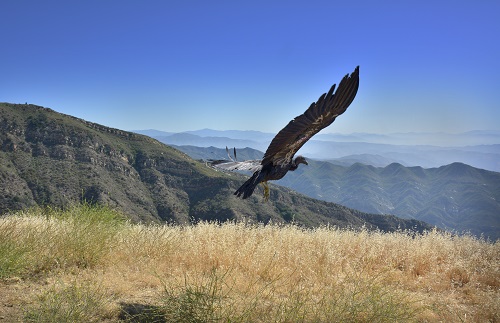 You may have heard that the Los Angeles Clippers unveiled their new mascot Chuck the Condor at Monday’s game against the New York Nets, and while the reactions were mixed, we think Clippers’ fans will learn to love condors as much as we do. Like the Los Angeles Clippers, California condors were fighting a losing battle in the 1980s. Plagued with injuries to the team’s star players and poor performances, the Clippers finished their 1987 season at 12-70, the second worst single-season on record in NBA history.
You may have heard that the Los Angeles Clippers unveiled their new mascot Chuck the Condor at Monday’s game against the New York Nets, and while the reactions were mixed, we think Clippers’ fans will learn to love condors as much as we do. Like the Los Angeles Clippers, California condors were fighting a losing battle in the 1980s. Plagued with injuries to the team’s star players and poor performances, the Clippers finished their 1987 season at 12-70, the second worst single-season on record in NBA history.
Around the same time, California condors were being wiped out of their native range and killed off by lead poisoning, which weakens their immune system and leads to death with continued over exposure. The worldwide population of wild condors was down to only 23 in 1983 — and by 1987, wildlife biologists were forced to bring in all remaining condors from the wild to prevent extinction. Watch the last condor capture on April 19, 1987.
In the 1990s and 2000s, the Clippers began to build a team that would ultimately rise to the top in the NBA. And so, too, began efforts to return soaring California condors to the skies of southern California.
The Clippers finished their 1991-1992 season with a record of 45-37, their best in 13 years. They even earned strong bragging rights against cross-town rivals, the Los Angeles Lakers, for beating their season record. That same year, the U.S. Fish and Wildlife Service began reintroducing California condors back into the wild, following the establishment of the multi-partner California Condor Recovery Program.

By 2006, hard work and perseverance began to pay off for the Clippers, winning their first NBA playoff game in more than a decade. Just two years later in 2008, partners with the California Condor Recovery Program celebrated a milestone of their own with more California condors flying free in the wild than in captivity for the first time since the program began in 1992. Learn about the release of California condor #20, a 35-year old condor that played a pivotal role in recovery efforts.
Saving the California condor from extinction has not been an easy task, but much like Clippers fans, condor supporters have stuck by the program through thick and thin. Victories are not only a result of the key players, but also from a strong support system of many dedicated partners.
Today, the Los Angeles Clippers hold two consecutive division titles in the 2013 and 2014 seasons, and with hard work, talented players and a strong team of supporters, are looking forward to a bright future in the Western Conference.
And as for California condors and the biologists, veterinarians, volunteers, and supporters who work to recover them, we too see a bright future ahead. Today, as a result of the reintroduction program and ongoing management activities, there are 268 California condors in the wild. In the final phase of the recovery program, we’re working with our partners to build self-sustaining populations, educate the public about the threats impacting these birds in the wild, and tell their story of tragedy and triumph.
So basketball fans, we hope you share our pride in telling the story of the California condor, North America’s largest bird with a strong will to fight against all odds, and your new team mascot for the Los Angeles Clippers. We invite the Los Angeles Clippers to join our biologists for the once-in-a-lifetime opportunity to see California condors in the wild. We promise the experience will be a real game changer. Learn more: http://www.fws.gov/cno/es/CalCondor/Condor.cfm
Why California Condors Dominate the Skies
The California condor (Gymnogyps californianus), with a wingspan of 9.5 feet and weighing up to 25 pounds, is the largest land bird in North America. California condors can soar on warm thermal updrafts for hours, reaching speeds of more than 55 miles per hour and altitudes of 15,000 feet. Flights in excess of 150 miles in a day have been recorded. These majestic creatures historically ranged from California to Florida and Western Canada to Northern Mexico. By the mid-20th century, condor populations had dropped dramatically, and by 1967 the California condor was listed as federally endangered.
California Condor Recovery is a Group Effort
California Condor Recovery Program partners include U.S. Fish and Wildlife Service, U.S. Forest Service, National Park Service, Bureau of Land Management, Arizona Game and Fish Department, California Department of Fish and Wildlife, Utah Department of Fish and Wildlife, the federal government of Mexico, the Yurok Tribe, San Diego Zoo, Los Angeles Zoo, Oregon Zoo, Santa Barbara Zoo, Chapultepec Zoo, The Peregrine Fund, Ventana Wildlife Society, and a host of other governmental and non-governmental organizations.
— Ashley Spratt, Public Affairs Officer , USFW
